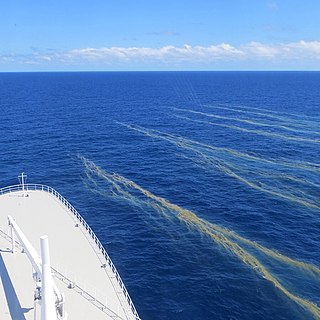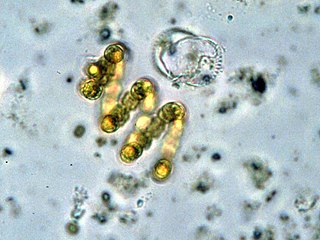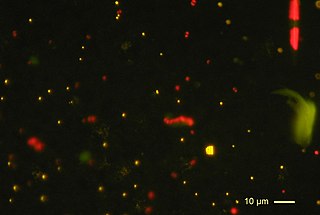
Cyanobacteria, also known as Cyanophyta, are a phylum of Gram-negative bacteria that obtain energy via photosynthesis. The name cyanobacteria refers to their color, giving them their other name, "blue-green algae", though modern botanists restrict the term algae to eukaryotes and do not apply it to cyanobacteria, which are prokaryotes. They appear to have originated in freshwater or a terrestrial environment. Sericytochromatia, the proposed name of the paraphyletic and most basal group, is the ancestor of both the non-photosynthetic group Melainabacteria and the photosynthetic cyanobacteria, also called Oxyphotobacteria.

Trichodesmium, also called sea sawdust, is a genus of filamentous cyanobacteria. They are found in nutrient poor tropical and subtropical ocean waters. Trichodesmium is a diazotroph; that is, it fixes atmospheric nitrogen into ammonium, a nutrient used by other organisms. Trichodesmium is thought to fix nitrogen on such a scale that it accounts for almost half of the nitrogen fixation in marine systems globally. Trichodesmium is the only known diazotroph able to fix nitrogen in daylight under aerobic conditions without the use of heterocysts.

Cyanotoxins are toxins produced by cyanobacteria. Cyanobacteria are found almost everywhere, but particularly in lakes and in the ocean where, under high concentration of phosphorus conditions, they reproduce exponentially to form blooms. Blooming cyanobacteria can produce cyanotoxins in such concentrations that they poison and even kill animals and humans. Cyanotoxins can also accumulate in other animals such as fish and shellfish, and cause poisonings such as shellfish poisoning.

Nostoc, also known as star jelly, troll’s butter, witch's butter, and witch’s jelly, is a genus of cyanobacteria found in various environments that forms colonies composed of filaments of moniliform cells in a gelatinous sheath.

Biological soil crusts are communities of living organisms on the soil surface in arid and semi-arid ecosystems. They are found throughout the world with varying species composition and cover depending on topography, soil characteristics, climate, plant community, microhabitats, and disturbance regimes. Biological soil crusts perform important ecological roles including carbon fixation, nitrogen fixation and soil stabilization; they alter soil albedo and water relations and affect germination and nutrient levels in vascular plants. They can be damaged by fire, recreational activity, grazing and other disturbances and can require long time periods to recover composition and function. Biological soil crusts are also known as biocrusts or as cryptogamic, microbiotic, microphytic, or cryptobiotic soils.

The Nostocaceae are a family of cyanobacteria that forms filament-shaped colonies enclosed in mucus or a gelatinous sheath. Some genera in this family are found primarily in fresh water, while others are found primarily in salt water. Other genera may be found in both fresh and salt water. Most benthic algae of the order Nostocales belong to this family.
Photoprotection is the biochemical process that helps organisms cope with molecular damage caused by sunlight. Plants and other oxygenic phototrophs have developed a suite of photoprotective mechanisms to prevent photoinhibition and oxidative stress caused by excess or fluctuating light conditions. Humans and other animals have also developed photoprotective mechanisms to avoid UV photodamage to the skin, prevent DNA damage, and minimize the downstream effects of oxidative stress.

Biological pigments, also known simply as pigments or biochromes, are substances produced by living organisms that have a color resulting from selective color absorption. Biological pigments include plant pigments and flower pigments. Many biological structures, such as skin, eyes, feathers, fur and hair contain pigments such as melanin in specialized cells called chromatophores. In some species, pigments accrue over very long periods during an individual's lifespan.

Photosynthetic picoplankton or picophytoplankton is the fraction of the phytoplankton performing photosynthesis composed of cells between 0.2 and 2 µm in size (picoplankton). It is especially important in the central oligotrophic regions of the world oceans that have very low concentration of nutrients.

Synechococcus is a unicellular cyanobacterium that is very widespread in the marine environment. Its size varies from 0.8 to 1.5 µm. The photosynthetic coccoid cells are preferentially found in well–lit surface waters where it can be very abundant. Many freshwater species of Synechococcus have also been described.

Geosiphon is a genus of fungus in the family Geosiphonaceae. The genus is monotypic, containing the single species Geosiphon pyriformis, first described by Kützing in 1849 as Botrydium pyriforme. In 1915, Von Wettstein characterized Geosiphon pyriforme as a multinucleate alga containing endosymbiotic cyanobacteria, although he also noted the presence of chitin, a component of fungal cell walls. In 1933, Knapp was the first to suggest the fungal origin of the species and described it as a lichen with endosymbiotic cyanobacteria. It is the only member of the Glomeromycota known to not form a symbiosis with terrestrial plants in the form of arbuscular mycorrhiza.
Cyanobionts are cyanobacteria that live in symbiosis with a wide range of organisms such as terrestrial or aquatic plants; as well as, algal and fungal species. They can reside within extracellular or intracellular structures of the host. In order for a cyanobacterium to successfully form a symbiotic relationship, it must be able to exchange signals with the host, overcome defense mounted by the host, be capable of hormogonia formation, chemotaxis, heterocyst formation, as well as possess adequate resilience to reside in host tissue which may present extreme conditions, such as low oxygen levels, and/or acidic mucilage. The most well-known plant-associated cyanobionts belong to the genus Nostoc. With the ability to differentiate into several cell types that have various functions, members of the genus Nostoc have the morphological plasticity, flexibility and adaptability to adjust to a wide range of environmental conditions, contributing to its high capacity to form symbiotic relationships with other organisms. Several cyanobionts involved with fungi and marine organisms also belong to the genera Richelia, Calothrix, Synechocystis, Aphanocapsa and Anabaena, as well as the species Oscillatoria spongeliae. Although there are many documented symbioses between cyanobacteria and marine organisms, little is known about the nature of many of these symbioses. The possibility of discovering more novel symbiotic relationships is apparent from preliminary microscopic observations.
Mycosporine-like amino acids (MAAs) are small secondary metabolites produced by organisms that live in environments with high volumes of sunlight, usually marine environments. The exact number of compounds within this class of natural products is yet to be determined, since they have only relatively recently been discovered and novel molecular species are constantly being discovered; however, to date their number is around 30. They are commonly described as “microbial sunscreens” although their function is believed not to be limited to sun protection. MAAs represent high potential in cosmetics, and biotechnological applications. Indeed, their UV-absorbing properties would allow to create products derived from natural photoprotectors, potentially harmless to the environment and efficient against UV damage.

Planktothrix is a diverse genus of filamentous cyanobacteria observed to amass in algal blooms in water ecosystems across the globe. Like all Oscillatoriales, Planktothrix species have no heterocysts and no akinetes. Planktothrix are unique because they have trichomes and contain gas vacuoles unlike typical planktonic organisms. Previously, some species of the taxon were grouped within the genus Oscillatoria, but recent work has defined Planktothrix as its own genus. A tremendous body of work on Planktothrix ecology and physiology has been done by Anthony E. Walsby, and the 55.6 kb microcystin synthetase gene which gives these organisms the ability to synthesize toxins has been sequenced. P. agardhii is an example of a type species of the genus. P. agardhii and P. rubescens are commonly observed in lakes of the Northern Hemisphere where they are known producers of potent hepatotoxins called microcystins.

Scytonemin is a secondary metabolite and an extracellular matrix (sheath) pigment synthesized by many strains of cyanobacteria, including Nostoc, Scytonema, Calothrix, Lyngbya, Rivularia, Chlorogloeopsis, and Hyella. Scytonemin-synthesizing cyanobacteria often inhabit highly insolated terrestrial, freshwater and coastal environments such as deserts, semideserts, rocks, cliffs, marine intertidal flats, and hot springs.
Cylindrospermopsis raciborskii is a freshwater cyanobacterium.

Nostoc commune is a species of cyanobacterium in the family Nostocaceae. Common names include star jelly, witch's butter, mare's eggs, fah-tsai and facai. It is the type species of the genus Nostoc and is cosmopolitan in distribution.

Cyanothece is a genus of unicellular, diazotrophic, oxygenic photosynthesizing cyanobacteria.

Marine primary production is the chemical synthesis in the ocean of organic compounds from atmospheric or dissolved carbon dioxide. It principally occurs through the process of photosynthesis, which uses light as its source of energy, but it also occurs through chemosynthesis, which uses the oxidation or reduction of inorganic chemical compounds as its source of energy. Almost all life on Earth relies directly or indirectly on primary production. The organisms responsible for primary production are called primary producers or autotrophs.

Cyanobacteria are a large and diverse phylum of bacteria defined by their unique combination of pigments and their ability to perform oxygenic photosynthesis.

















